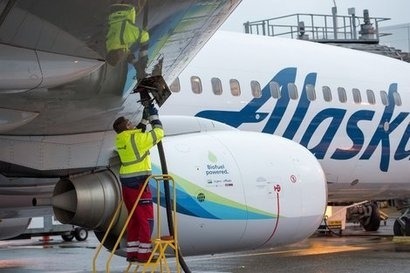
Residual wood consists of the limbs and branches that remain after the harvesting of managed forests. The alternative jet fuel was produced through the efforts of the Washington State University-led Northwest Advanced Renewables Alliance (NARA).
The demonstration flight departed Seattle-Tacoma International Airport earlier this morning for Reagan National Airport in Washington, D.C. The flight was fueled with a 20 percent blend of sustainable aviation biofuel, which is chemically indistinguishable from regular jet A fuel. The flight, the first commercial passenger flight of its kind, continues to advance viable alternatives to conventional fossil fuels for aviation.
Gevo, Inc., a NARA partner, successfully adapted its patented technologies to convert cellulosic sugars derived from wood waste into renewable isobutanol, which was then further converted into Gevo's Alcohol-to-Jet (ATJ) fuel. Believed to be the world's first alternative jet fuel produced from wood, the fuel meets international ASTM standards, allowing it to be used safely for today's commercial flight.
“This latest milestone in Alaska's efforts to promote sustainable biofuels is especially exciting since it is uniquely sourced from the forest residuals in the Pacific Northwest” said Joe Sprague, Alaska Airlines' senior vice president of communications and external relations. “NARA's accomplishments and the investment of the US Department of Agriculture provide another key in helping Alaska Airlines and the aviation industry reduce its carbon footprint and dependency on fossil fuels.”
Pat Gruber, Gevo's Chief Executive Officer, added that the flight, the first of its kind, demonstrates Gevo's commitment and ability to convert a wide range of sugar feedstocks into drop-in renewable fuels. Gruber stated that the company is pleased to have had the opportunity to prove, through the NARA project, that cellulosic sugars from wood can be used to successfully make commercial jet fuel. Gevo has also congratulated all of its fellow NARA partners and the USDA-NIFA, for its support in the pursuit of renewable jet fuel.
While the 1,080 gallons of biofuel used on the flight has a minimal impact to Alaska Airlines' overall greenhouse gas emissions, if the airline were able to replace 20 percent of its entire fuel supply at Sea-Tac Airport, it would reduce greenhouse gas emissions by about 142,000 metric tons of CO2. This is equivalent to taking approximately 30,000 passenger vehicles off the road for one year.
NARA is a five-year project that launched in 2011 and is comprised of 32 member organizations from industry, academia and government laboratories. Today's flight represents its efforts to develop alternative jet fuel derived from post-harvest forestry material that is often burned after timber harvest. The forest residual feedstock used to power Alaska Airlines Flight 4 was sourced from tribal lands and private forestry operations in the Pacific Northwest. In addition to producing 1,080 gallons of biofuel used for the flight, other key tasks of the project included evaluating the economic, environmental, and societal benefits and impacts associated with harvesting unused forest residuals for biofuel production.
The NARA initiative was made possible by a $39.6 million grant from the National Institute of Food and Agriculture (NIFA) to support research on biofuels and biochemicals, foster regional supply chain coalitions, empower rural economic development and educate the public on the benefits of bioenergy.
Several elected officials joined the 163 passengers on the Alaska Airlines Boeing 737-800 jet bound for the nation's capital, including Congresswoman Suzan DelBene, Congressman Dave Reichert, and Congressman Denny Heck.
Alaska Airlines flew two other flights in June using a blend of biofuel produced from non-edible, sustainable corn.
Image: PR Newswire
For additional information:

